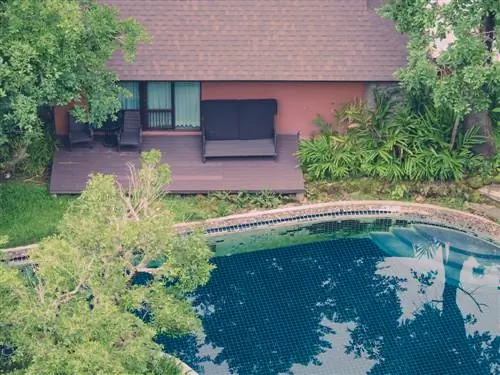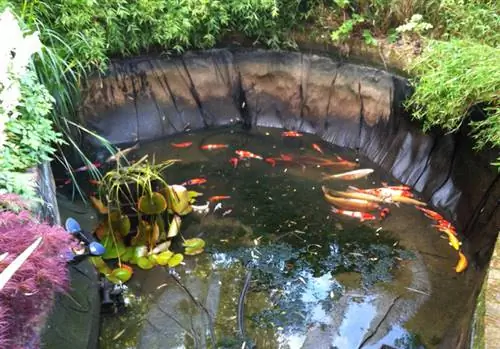- Author admin [email protected].
- Public 2023-12-16 16:46.
- Last modified 2025-01-23 11:21.
Keeping a swimming pond clean and algae-free with chlorine has the advantage that your pond water will remain almost completely clear throughout the entire season. Very little effort is required, the costs for 10 to 20 kg of chlorine are also kept within limits, but nature falls by the wayside.

Can you clean a swimming pond with chlorine?
A swimming pond with chlorine keeps the water clear and free of algae, but can harm nature. Alternatives include disinfection with active oxygen or ozone. However, a naturally created swimming pond with a regeneration area enables biological cleaning and is more environmentally friendly.
In traditional swimming pools, the purity and clarity of the pool water is achieved through sometimes considerable amounts of chlorine and other chemicals. Bacteria and mainly algae are kept in check by the toxic components contained in this chemical disinfectant solution and have no chance of spreading significantly, which is not good for human skin at all.
Swimming ponds have self-cleaning powers
And they are even stronger in the natural pool, the better the biological balance can be achieved. The spatial separation of the bathing and regeneration area by a wall in the pool breaks down excess nutrients completely naturally, prevents the formation of algae and eliminates pathogens on its own. Nevertheless, clean water is the be-all and end-all for a naturally he althy swimming pond, so every owner has to make their own decision in favor of the chemical or biological option.
The disinfectant effect of chlorine
The germicidal effect, also known as cold combustion, is chemically based on the oxidation between chlorine molecules and the organic impurities in the pond water, which cannot be removed by filters. A distinction is made between inorganic water care products, which release their chlorine components immediately in the pond, and those based on organic materials, which only work when the chlorine content in the pool falls below a certain level. Available as granules or in tablet form, chlorine is added to the pond water using adjustable or automatic dosing systems. Relatively new on the market are electrolysis systems that are installed near the pool and produce chlorine independently.
Regulation of chlorine requirements and alternatives
The testing of the chlorine levels in the water must be analyzed and readjusted regularly using special measuring utensils, test strips (€18.00 on Amazon) or commercially available hand-held measuring devices. Of course, the general tolerance of bathers to chlorine also plays an important role, as it is much harder to endure chlorine water if you have red eyes or burning skin. Otherwise, in addition to the natural nature of the pool, there are also the following alternatives to a swimming pond with chlorine:
- Disinfection with active oxygen;
- Cleaning the swimming pond water with ozone, which reverts to the original oxygen molecules after disinfection;
Tip
Thanks to its integrated filters and aquatic plants in the regeneration area, an artificial swimming pond also has an excellent biological cleaning system that is completely maintenance-free and comparatively inexpensive. The decision in favor of a classic and natural look should therefore not be difficult.






